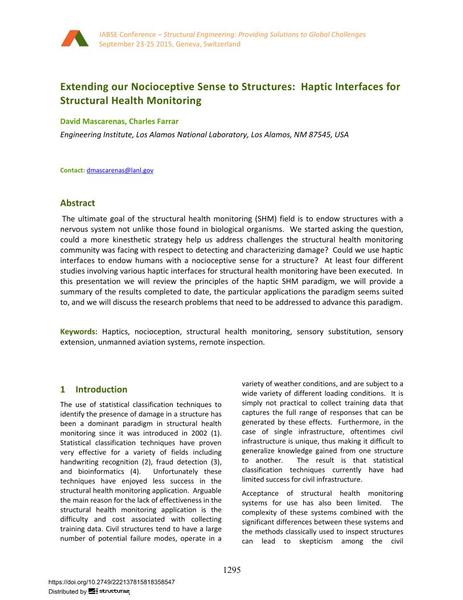Extending our Nocioceptive Sense to Structures: Haptic Interfaces for Structural Health Monitoring

|
|
|||||||||||
Bibliographic Details
| Author(s): |
David Mascareñas
(Engineering Institute, Los Alamos National Laboratory, Los Alamos, NM 87545, USA)
Charles Farrar (Engineering Institute, Los Alamos National Laboratory, Los Alamos, NM 87545, USA) |
||||
|---|---|---|---|---|---|
| Medium: | conference paper | ||||
| Language(s): | English | ||||
| Conference: | IABSE Conference: Structural Engineering: Providing Solutions to Global Challenges, Geneva, Switzerland, September 2015 | ||||
| Published in: | IABSE Conference Geneva 2015 | ||||
|
|||||
| Page(s): | 1295-1302 | ||||
| Total no. of pages: | 8 | ||||
| Year: | 2015 | ||||
| DOI: | 10.2749/222137815818358547 | ||||
| Abstract: |
The ultimate goal of the structural health monitoring (SHM) field is to endow structures with a nervous system not unlike those found in biological organisms. We started asking the question, could a more kinesthetic strategy help us address challenges the structural health monitoring community was facing with respect to detecting and characterizing damage? Could we use haptic interfaces to endow humans with a nocioceptive sense for a structure? At least four different studies involving various haptic interfaces for structural health monitoring have been executed. In this presentation we will review the principles of the haptic SHM paradigm, we will provide a summary of the results completed to date, the particular applications the paradigm seems suited to, and we will discuss the research problems that need to be addressed to advance this paradigm. |
||||
| Keywords: |
structural health monitoring Haptics nocioception sensory substitution sensory extension unmanned aviation systems remote inspection
|
||||
